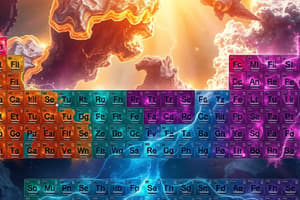Podcast
Questions and Answers
Which property generally decreases across a period on the periodic table?
Which property generally decreases across a period on the periodic table?
- Atomic size (correct)
- Physical properties
- Electron configuration
- Number of electron shells
In the periodic table, elements in the same group share which of the following?
In the periodic table, elements in the same group share which of the following?
- Different atomic numbers
- Same number of electron shells
- Varied chemical properties
- Similar electron configurations (correct)
What defines the horizontal rows on the periodic table?
What defines the horizontal rows on the periodic table?
- Atomic size
- Physical properties
- Number of electron shells (correct)
- Electron configuration
In the periodic table, what generally increases down a group?
In the periodic table, what generally increases down a group?
Which aspect of elements helps us predict their behavior under certain conditions?
Which aspect of elements helps us predict their behavior under certain conditions?
Which property generally decreases down a group in the periodic table?
Which property generally decreases down a group in the periodic table?
In terms of electron configuration, which principle states that no two electrons in an atom can have the same set of quantum numbers?
In terms of electron configuration, which principle states that no two electrons in an atom can have the same set of quantum numbers?
Which type of element generally has properties that are intermediate between metals and non-metals?
Which type of element generally has properties that are intermediate between metals and non-metals?
Which trend typically increases across a period in the periodic table?
Which trend typically increases across a period in the periodic table?
What is a defining characteristic of non-metals when it comes to ionization energy?
What is a defining characteristic of non-metals when it comes to ionization energy?
Flashcards are hidden until you start studying
Study Notes
The Class 11 Periodic Table: Your Coding Cheat Sheet for the Elemental World
When you're hanging out in Class 11, you'll discover the periodic table, a map of the elements, and their unique properties. It's like a treasure trove for understanding how elements are classified and organized, making it easier to predict their behavior. Let's dive into the essentials: groups, periods, trends, and electron configurations.
The Periodic Table: Your Elemental Roadmap
The periodic table is a two-dimensional arrangement of elements organized by atomic number and recurring properties. The elements are arranged into rows known as periods and columns called groups.
Groups and Periods: Finding Your Way Around
- Groups (also known as families or series) are vertical columns where elements have similar electron configurations and share common chemical properties.
- Periods are horizontal rows where elements have the same number of electron shells and generally exhibit similar atomic and physical properties.
Trends: Spotting Patterns in Properties
By studying the periodic table, we observe trends in the properties of elements. These trends help us understand and predict how elements will behave under certain conditions.
- Atomic size: Atomic size generally decreases across a period, while it increases down a group.
- Ionization energy: A measure of how much energy is required to remove an electron from an atom, typically increases across a period and decreases down a group.
- Electron affinity: A measure of how much energy is released when an electron is added to a neutral atom, generally increases down a group.
- Electronegativity: A measure of an atom's tendency to attract electrons to itself, typically increases across a period and decreases down a group.
Electron Configuration: Filling the Orbitals
The periodic table is based on the arrangement of electrons in atomic orbitals. The electron configuration describes the arrangement of electrons in an atom and is a crucial factor in determining an element's chemical properties.
- Electrons fill orbitals according to their energy levels and the Pauli Exclusion Principle, which states that no two electrons in an atom can have the same set of quantum numbers.
- The electronic configuration is usually written as the principal quantum number (n), followed by the orbital type (s, p, d, or f), and then the number of electrons in that orbital.
Types of Elements: Classifying by Behavior
Elements are classified based on their atomic structure and chemical behavior.
- Metals: Generally have low ionization energy, and lose electrons to form positive ions; found on the left side of the periodic table.
- Non-metals: Generally have high ionization energy, and gain electrons to form negative ions; found on the right side of the periodic table.
- Metalloids (also known as semi-metals): Have properties that are intermediate between metals and non-metals; found in the middle of the periodic table.
The periodic table is a powerful tool that unites the physical and chemical properties of elements. With a solid understanding of groups, periods, trends, and electron configurations, you'll be well-equipped to navigate this essential resource. And remember, there are no searches required—it's all right there in front of you.
Studying That Suits You
Use AI to generate personalized quizzes and flashcards to suit your learning preferences.




